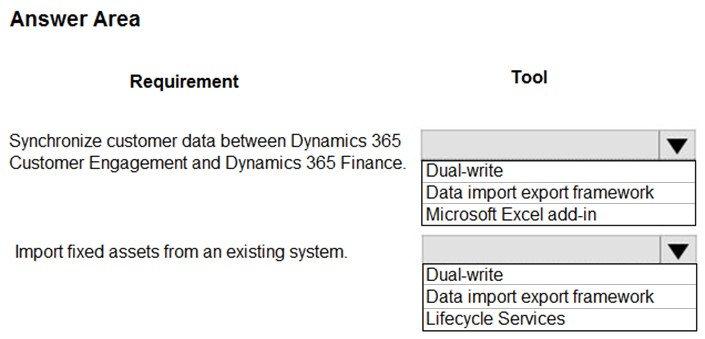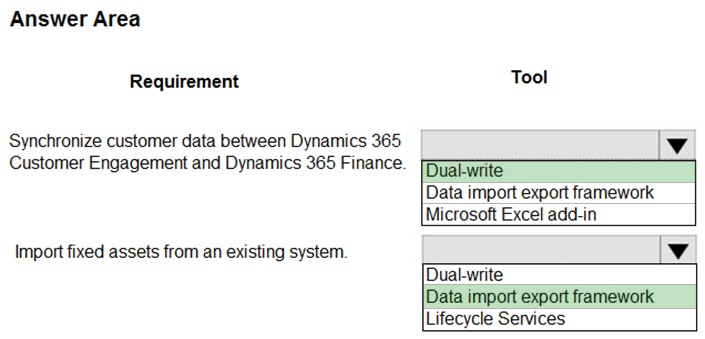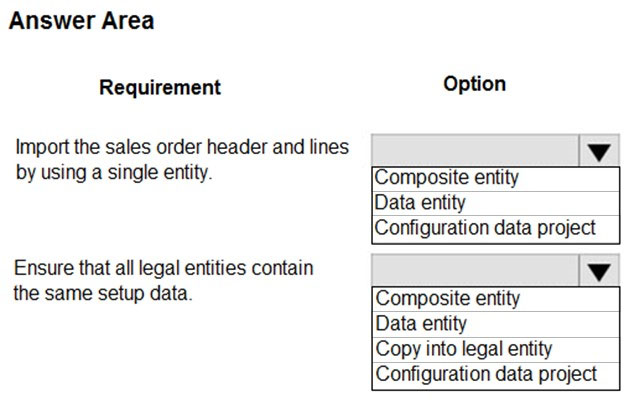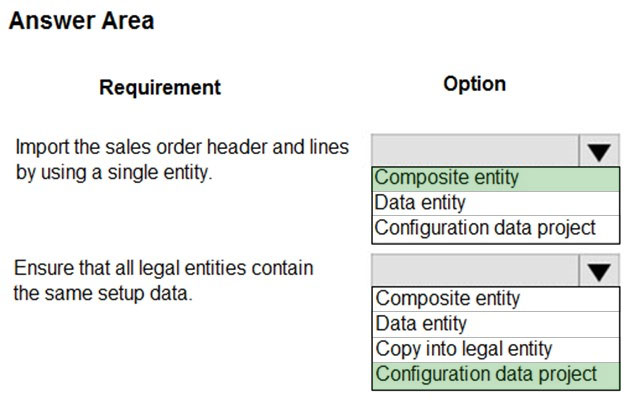Note: This question is part of a series of questions that present the same scenario. Each question in the series contains a unique solution that might meet the stated goals. Some question sets might have more than one correct solution, while others might not have a correct solution.
After you answer a question in this section, you will NOT be able to return to it. As a result, these questions will not appear in the review screen.
You are developing a file-based integration to Dynamics 365 Finance.
Microsoft Excel files with 15,000 or more records need to be imported into the system periodically by individual users. The records need to be imported in full within a 5-minute approved window.
You need to determine how to accomplish the import into the system.
Solution: Import the data by using the recurring data integrations API.
Does the solution meet the goal?
Answer:
A
References:
https://docs.microsoft.com/en-us/dynamics365/fin-ops-core/dev-itpro/data-entities/integration-overview https://docs.microsoft.com/en-us/dynamics365/fin-ops-core/dev-itpro/data-entities/data-management-api
Note: This question is part of a series of questions that present the same scenario. Each question in the series contains a unique solution that might meet the stated goals. Some question sets might have more than one correct solution, while others might not have a correct solution.
After you answer a question in this section, you will NOT be able to return to it. As a result, these questions will not appear in the review screen.
You are developing a file-based integration to Dynamics 365 Finance.
Microsoft Excel files with 15,000 or more records need to be imported into the system periodically by individual users. The records need to be imported in full within a 5-minute approved window.
You need to determine how to accomplish the import into the system.
Solution: Import the data by using the Data Management Framework's package API.
Does the solution meet the goal?
Answer:
B
References:
https://docs.microsoft.com/en-us/dynamics365/fin-ops-core/dev-itpro/data-entities/integration-overview https://docs.microsoft.com/en-us/dynamics365/fin-ops-core/dev-itpro/data-entities/data-management-api
Note: This question is part of a series of questions that present the same scenario. Each question in the series contains a unique solution that might meet the stated goals. Some question sets might have more than one correct solution, while others might not have a correct solution.
After you answer a question in this section, you will NOT be able to return to it. As a result, these questions will not appear in the review screen.
You are developing a file-based integration to Dynamics 365 Finance.
Microsoft Excel files with 15,000 or more records need to be imported into the system periodically by individual users. The records need to be imported in full within a 5-minute approved window.
You need to determine how to accomplish the import into the system.
Solution: Import the data by using the Excel Add-in.
Does the solution meet the goal?
Answer:
B
References:
https://docs.microsoft.com/en-us/dynamics365/fin-ops-core/dev-itpro/data-entities/integration-overview https://docs.microsoft.com/en-us/dynamics365/fin-ops-core/dev-itpro/data-entities/data-management-api
Note: This question is part of a series of questions that present the same scenario. Each question in the series contains a unique solution that might meet the stated goals. Some question sets might have more than one correct solution, while others might not have a correct solution.
After you answer a question in this section, you will NOT be able to return to it. As a result, these questions will not appear in the review screen.
You are a Dynamics 365 Finance system administrator. You have a test environment that is used by several people at any given time.
You create a new data entity in your development environment and migrate the code to the test environment. In the test environment, you are unable to find the data entity in the list.
You need to locate the data entity.
Solution: Reopen the client browser.
Does the solution meet the goal?
Answer:
B
Note: This question is part of a series of questions that present the same scenario. Each question in the series contains a unique solution that might meet the stated goals. Some question sets might have more than one correct solution, while others might not have a correct solution.
After you answer a question in this section, you will NOT be able to return to it. As a result, these questions will not appear in the review screen.
You are a Dynamics 365 Finance system administrator. You have a test environment that is used by several people at any given time.
You create a new data entity in your development environment and migrate the code to the test environment. In the test environment, you are unable to find the data entity in the list.
You need to locate the data entity.
Solution: In the Data management framework parameter screen, refresh the Entity list.
Does the solution meet the goal?
Answer:
A
HOTSPOT -
A company uses Dynamics 365 Customer Engagement. The company plans to implement Dynamics 365 Finance.
The company must be able to synchronize customer data between both systems. The company must be able to import fixed assets from an existing system and implement offline catch-up synchronization capabilities.
You need to implement data management tools.
Which tools should you use? To answer, select the appropriate options in the answer area.
NOTE: Each correct selection is worth one point.
Hot Area:
Answer:

Reference:
https://docs.microsoft.com/en-us/dynamics365/fin-ops-core/dev-itpro/data-entities/dual-write/dual-write-overview
A company implements Dynamics 365 Finance and Dynamics 365 Customer Service.
For which two scenarios can you use Dual Write? Each correct answer presents a complete solution.
NOTE: Each correct selection is worth one point.
Answer:
AD
Reference:
https://docs.microsoft.com/en-us/dynamics365/fin-ops-core/dev-itpro/data-entities/dual-write/dual-write-overview
HOTSPOT -
A company is implementing Dynamics 365 Finance and Dynamics 365 Supply Chain Management. The company is preparing to migrate data to the new systems.
You need to import sales order headers and lines by using a single entity. All legal entities must contain the same setup data.
What should you use? To answer, select the appropriate options in the answer area.
NOTE: Each correct selection is worth one point.
Hot Area:
Answer:

Reference:
https://docs.microsoft.com/en-us/dynamics365/fin-ops-core/dev-itpro/data-entities/develop-composite-data-entities https://docs.microsoft.com/en-us/dynamics365/fin-ops-core/dev-itpro/data-entities/copy-configuration
Note: This question is part of a series of questions that present the same scenario. Each question in the series contains a unique solution that might meet the stated goals. Some question sets might have more than one correct solution, while others might not have a correct solution.
After you answer a question in this section, you will NOT be able to return to it. As a result, these questions will not appear in the review screen.
You have the following Dynamics 365 Finance instances:
You must copy the configuration data from CompanyA to CompanyB.
Solution: Use Copy into legal entity.
Does the solution meet the goal?
Answer:
B
Reference:
https://docs.microsoft.com/en-us/dynamics365/fin-ops-core/dev-itpro/data-entities/copy-configuration
A company is migrating address data from an external system to Dynamics 365 Finance. The company has one data package with three entities that contain dependencies:
✑ Cities
✑ States
✑ Postal codes
You need to sequence the data entities within the data package.
To which sequence should you assign cities?
Answer:
C